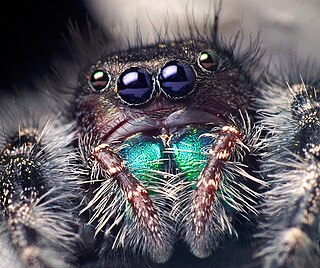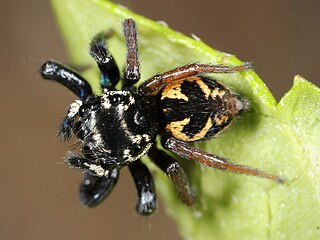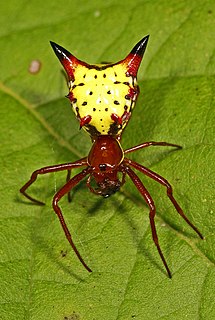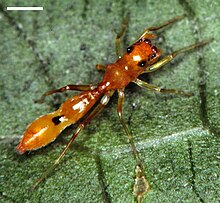
Phidippus is a genus in the family Salticidae. Some of the largest jumping spiders inhabit this genus, and many species are characterized by their brilliant, iridescent green chelicerae. Phidippus is distributed almost exclusively in North America, with the exception of two exported species. As of 2004, there are 60 valid described species in the genus. Species previously described in Phidippus which are found in India and Bangladesh do not belong in this genus.

Beata is a genus of jumping spiders that was first described by George Peckham & Elizabeth Peckham in 1895.

Breda is a genus of jumping spiders that was first described by George Peckham & Elizabeth Peckham in 1894.

Chira is a genus of jumping spiders that was first described by George Peckham & Elizabeth Peckham in 1896. It is currently named after Rio Chira, a river in Peru, but the Peckhams originally called the genus Shira, later emended by Eugène Simon.

Corythalia is a genus of jumping spiders that was first described by Carl Ludwig Koch in 1850.

Cotinusa is a genus of jumping spiders that was first described by Eugène Louis Simon in 1900.

Freya is a genus of jumping spiders that was first described by Carl Ludwig Koch in 1850. The name is derived from Freya, the fertility goddess of Norse mythology.

Lyssomanes is a spider genus of the family Salticidae, ranging from South and Central America, up to the southern United States.

Pachomius is a genus of jumping spiders that was first described by George and Elizabeth Peckham in 1896. Uspachia was merged into genus Romitia in 2007, and all nine species were merged into Pachomius in 2015. The name is derived from Pachomius, the founder of cenobitic monasticism.

Phiale is a genus of jumping spiders that was first described by Carl Ludwig Koch in 1846. P. albovittata has been considered a junior synonym of Freya perelegans since 2006.

Sarinda is a genus of ant mimicking jumping spiders that was first described by George and Elizabeth Peckham in 1892.

Sassacus is a genus of jumping spiders that was first described by George and Elizabeth Peckham in 1895. It is likely named after Sassacus, a Native American chief of the 16th and 17th century.
Scopocira is a genus of jumping spiders that was first described by Eugène Louis Simon in 1900.

Zygoballus is a genus of jumping spiders found in North and South America.

Micrathena, known as spiny orbweavers, is a genus of orb-weaver spiders first described by Carl Jakob Sundevall in 1833. Micrathena contains more than a hundred species, most of them Neotropical woodland-dwelling species. The name is derived from the Greek "micro", meaning "small", and the goddess Athena.

The Dendryphantina are a subtribe of jumping spiders that occur mainly in the New World. The subtribe was first defined by Anton Menge in 1879 as Dendryphantidae. Females of the subtribe generally show paired spots on the abdomen, and the males often have enlarged chelicerae. Females in this subtribe typically have S-shaped epigynal openings.

Colonus is a genus of spiders in the jumping spider family, Salticidae. Colonus species are endemic to North and South America, ranging from New York to Argentina. All members of the genus have two pairs of bulbous spines on the ventral side of the first tibiae. The function of these spines is unknown. Colonus was declared a junior synonym of Thiodina by Eugène Simon in 1903, but this was reversed by Bustamante, Maddison, and Ruiz in 2015.

Mangora is a genus of orb-weaver spiders first described by O. Pickard-Cambridge in 1889.
Wagneriana is a genus of orb-weaver spiders first described by F. O. Pickard-Cambridge in 1904.



















